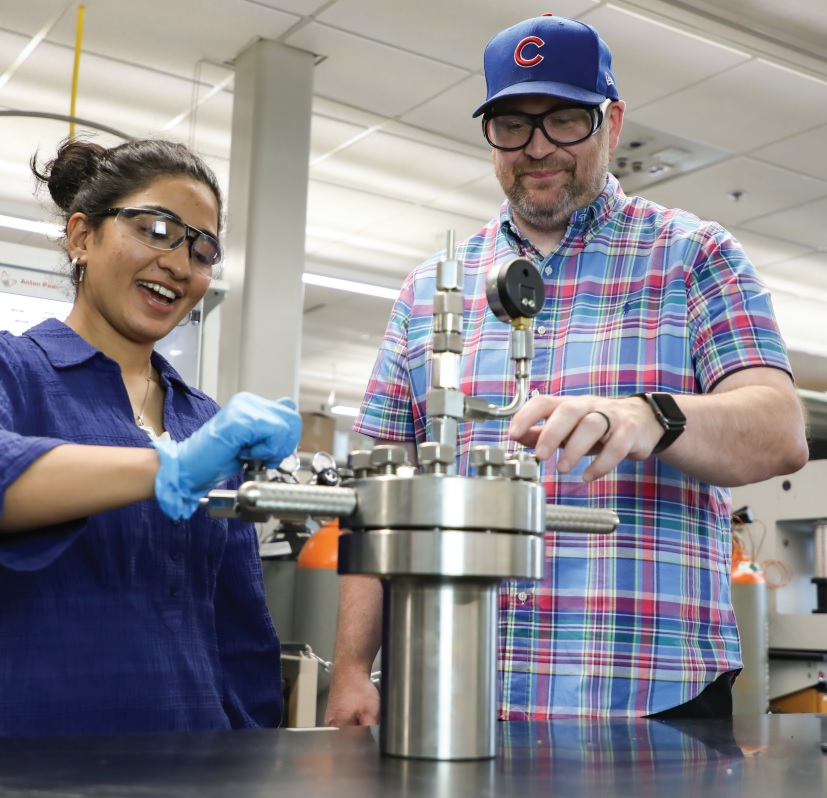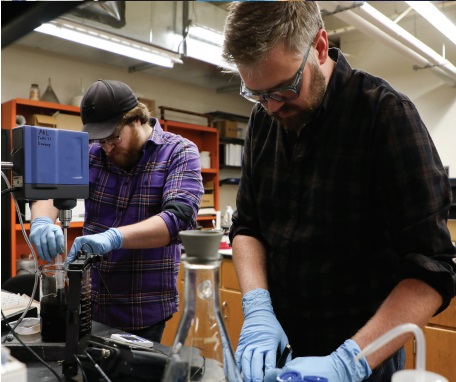CELEBRATING 10 YEARS OF THE MATERIALS SCIENCE PH.D. PROGRAM

In our ever-changing world, materials science quietly shapes the fabric of our lives. Materials scientists and
engineers are responsible for the very framework upon which our society rests, yet their work often goes
unnoticed. Dr. Grant Wallace, a Research Associate at Montana Tech, noted the common misconception:
“When people think of engineers, they don’t think about materials science as engineering. We take a lot of
this engineering for granted daily. Your car is just there, and your house exists, but all of these things are
made of materials, and someone has to make those materials.”
Dr. Wallace is one of the 15 graduates who have earned a Ph.D. in Materials Science since Montana Tech,
in collaboration with the University of Montana and Montana State University, introduced the program
a decade ago. While UM paused its involvement in 2018, the partnership with Montana State University
remains strong and continues to produce accomplished graduates.
According to Dr. Jerry Downey, the Materials Science and Engineering Graduate Program Director and
Metallurgical & Materials Engineering Department Head, “Since program inception, the Montana University
System collaborative Materials Science Ph.D. program has produced a total of 23 graduates, 15 of whom
earned their degree at Montana Tech. About one-third of our graduates opt to directly enter industry while
the others remain in academia. Three of our graduates, Drs. Rick LaDouceur, Nathan Huft, and Blaine
Berrington, have already assumed tenure-track Assistant Professor positions at Montana Tech, which
testifies to the program’s quality.”
This program plays a pivotal role in meeting the rising demand for materials scientists in both industry and
academia. It has facilitated high-level groundbreaking research funded by some of the nation’s most wellrespected agencies to tackle some of the most challenging issues facing society.

In 2014, Dr. Rick LaDouceur (B.S. General Engineering ’14 and PhD Materials Science ‘18) became part of
the first cohort of graduates in Montana Tech’s groundbreaking Ph.D. program. Reflecting on the program’s
distinctiveness, Dr. LaDouceur stated, “It’s a unique Ph.D. program. There isn’t another like it in the country.”
He highlighted the program’s key strengths: “You get the benefits of both facilities, you get the benefits of
both universities’ professors. You have this built-in inherent collaboration system already. The program
requires you to have a committee member on your Ph.D. dissertation committee from the other university.”
Dr. LaDouceur’s decision to pursue a Ph.D. was sparked by his fascination with the research process during
his participation in the Summer Undergraduate Research Fellowship Program at Montana Tech. He shared
his enthusiasm for the Ph.D. experience: “I enjoyed taking a problem that no one had solved before and
trying to come up with a solution for it. Ph.D. work really allows you to complete projects in your own time,
in your own way. You advance science in a way it hasn’t been advanced before. You only learn that skillset by
doing that work.”
Now, as an Assistant Professor of Mechanical Engineering, Dr. LaDouceur imparts his knowledge and passion for research to Orediggers, some of whom gain valuable laboratory experience by assisting him on projects involving biochar. Biochar, a residue of biomass burning, holds great potential for various purposes, including its use as a soil amendment for ecological restoration on former mining lands. Additionally, LaDouceur is exploring the possibility of turning hemp waste and expired food items from the Oredigger Food Pantry into value-added products. Dr. LaDouceur’s lab-produced biochar is also being utilized to test novel separation techniques for rare earth elements.
Dr. Teagan Leitzke (M.S. Materials Science and Engineering, ’20, Ph.D Materials Science ’22) is a post-doctoral researcher at Montana Tech who is charting a promising path in the world of materials science; she envisions a future working for a national laboratory. Dr. Leitzke’s Ph.D dissertation focused on the modification of a Continuous Flow Material Recovery (CFMR) system, which uses magnetite particles to remove and recover harmful contaminants from wastewaters. Dr. Leitzke’s research allowed her to delve into the adsorptive properties of magnetite and construct a larger version of the CFMR system. Dr. Leitzke is currently managing and providing technical oversight to two major projects. In a project funded by DEVCOM Army Research Laboratory, she is investigating a novel hightemperature method of refining and separating rare earth elements and, in a project funded by the Department of Energy, she is evaluating a method that utilizes waste plastics to recover iron and critical metals from the slags produced during copper smelting and electric arc furnace steelmaking. One of the key qualities Dr. Leitzke emphasizes for materials scientists is the ability to think on their feet. She believes that adaptability and the capacity to pivot between different types of work are essential in the ever-evolving field of materials science. “The field is very inter- and multi-disciplinary,” she explained. “Being flexible is also important, as things may change or not go as planned, and adapting to those changes or finding new ways to make things work is essential.”
Dr. Leitzke’s own journey through materials science showcases the wide array of opportunities within the field. She highlights that while you may find a particular area of research that you are passionate about, you can also explore various paths.
“As an example,” she said, “my bachelor’s was in physics, my master’s was on high-temperature processing, and then I moved into water chemistry for my Ph.D. Clearly, you don’t have to stick to one thing once you have your foot in the materials science door. You can find what works best for you, and as you grow and improve your skills, there may be other opportunities on a variety of topics involving different kinds of materials and materials processing that you might want to pursue.”
Ph.D. candidate Katie Schumacher (B.S. Metallurgical and Materials Engineering, ’07 and M.S. Metallurgical Engineering, ’09) is focusing her research on aerogels, which are ultralight, ultraporous, super insulating materials that have many uses, including insulating spacecraft and building spacesuits.
“Aerogels are synthesized by replacing the liquid portion of gel with a gas, leaving behind a light, ridged solid,” Schumacher said. “They are the lightest solid on Earth and Mars. They were traditionally made with silica, but researchers have expanded into using graphene, metal oxides, plant fibers, and so much more.”
Schumacher’s passion for aerogels lies in the uncharted territory of research. “I love aerogels because there is so much research left to be done. We have been studying them for over 90 years and have barely touched the tip of the iceberg.”
For Ph.D. candidate Alex George, metallic glass is the material of choice. These materials were only discovered in the 1960s, and are produced by rapidly cooling metal alloys made under high heat. They have bonds like metal, but the structure of their atoms is glasslike. While they are already used in medical equipment and surgical implants, many scientists believe they could lead a revolution in the materials industry. However, the
high cost of producing metallic glass is a challenge. George is attempting to reduce corrosion and make the material stronger in his study. While most of the graduates of the program have gone on to work in academia, George is focused on a career in industry.
“My goal has always been to go back into industrial research,” George said. “There are a lot of things that need to be done in the world, and there are demands for better performing materials. Going to school for this, you can be at the forefront of that.”
With 17 students currently enrolled in Montana Tech’s Ph.D. program, Dr. Downey reports that the program has capacity for expansion as more sponsored research projects are secured and the number of research-active faculty continues to grow.
The Metallurgical and Materials Engineering department’s outreach efforts included hosting 23 high school students
from across Montana and three other states for its inaugural Metallurgical and Materials Engineering summer camp last June.
The free week-long camp was organized to connect rising high school juniors and seniors with the diverse assortment of exciting career opportunities in this field. Activities included experiential learning exercises in the department’s extensive laboratory facilities, field trips to local industry, casting aluminum medallions, and forging steel knife blades.
As Dr. Downey emphasized, “The U.S. is facing a severe shortage of metallurgical engineers and materials scientists. Perhaps we will spark interest through this camp so that these
students will one day help to fill that need.”